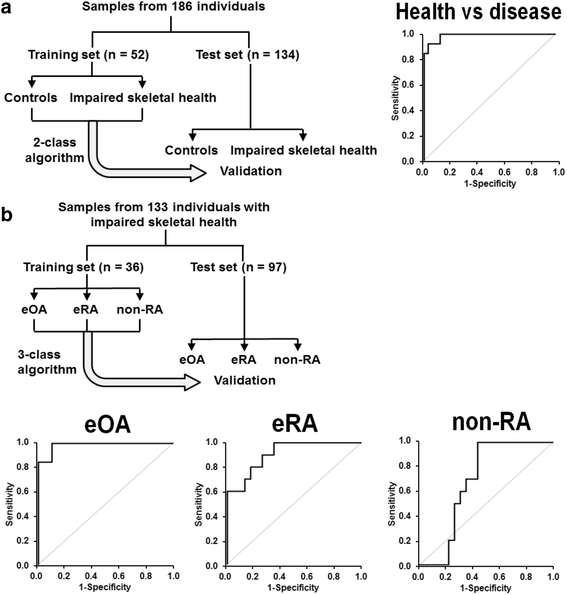Protein oxidation, nitration and glycation biomarkers for early-stage diagnosis of osteoarthritis of the knee and typing and progression of arthritic disease
- PMID: 27788684
- PMCID: PMC5081671
- DOI: 10.1186/s13075-016-1154-3
Protein oxidation, nitration and glycation biomarkers for early-stage diagnosis of osteoarthritis of the knee and typing and progression of arthritic disease
Abstract
Background: There is currently no blood-based test for detection of early-stage osteoarthritis (OA) and the anti-cyclic citrullinated peptide (CCP) antibody test for rheumatoid arthritis (RA) has relatively low sensitivity for early-stage disease. Morbidity in arthritis could be markedly decreased if early-stage arthritis could be routinely detected and classified by clinical chemistry test. We hypothesised that damage to proteins of the joint by oxidation, nitration and glycation, and with signatures released in plasma as oxidized, nitrated and glycated amino acids may facilitate early-stage diagnosis and typing of arthritis.
Methods: Patients with knee joint early-stage and advanced OA and RA or other inflammatory joint disease (non-RA) and healthy subjects with good skeletal health were recruited for the study (n = 225). Plasma/serum and synovial fluid was analysed for oxidized, nitrated and glycated proteins and amino acids by quantitative liquid chromatography-tandem mass spectrometry. Data-driven machine learning methods were employed to explore diagnostic utility of the measurements for detection and classifying early-stage OA and RA, non-RA and good skeletal health with training set and independent test set cohorts.
Results: Glycated, oxidized and nitrated proteins and amino acids were detected in synovial fluid and plasma of arthritic patients with characteristic patterns found in early and advanced OA and RA, and non-RA, with respect to healthy controls. In early-stage disease, two algorithms for consecutive use in diagnosis were developed: (1) disease versus healthy control, and (2) classification as OA, RA and non-RA. The algorithms featured 10 damaged amino acids in plasma, hydroxyproline and anti-CCP antibody status. Sensitivities/specificities were: (1) good skeletal health, 0.92/0.91; (2) early-stage OA, 0.92/0.90; early-stage RA, 0.80/0.78; and non-RA, 0.70/0.65 (training set). These were confirmed in independent test set validation. Damaged amino acids increased further in severe and advanced OA and RA.
Conclusions: Oxidized, nitrated and glycated amino acids combined with hydroxyproline and anti-CCP antibody status provided a plasma-based biochemical test of relatively high sensitivity and specificity for early-stage diagnosis and typing of arthritic disease.
Keywords: 3-nitrotyrosine; Glycation; Machine learning; Osteoarthritis; Oxidative stress; Rheumatoid arthritis.
Figures


References
Publication types
MeSH terms
Substances
LinkOut - more resources
Full Text Sources
Other Literature Sources

